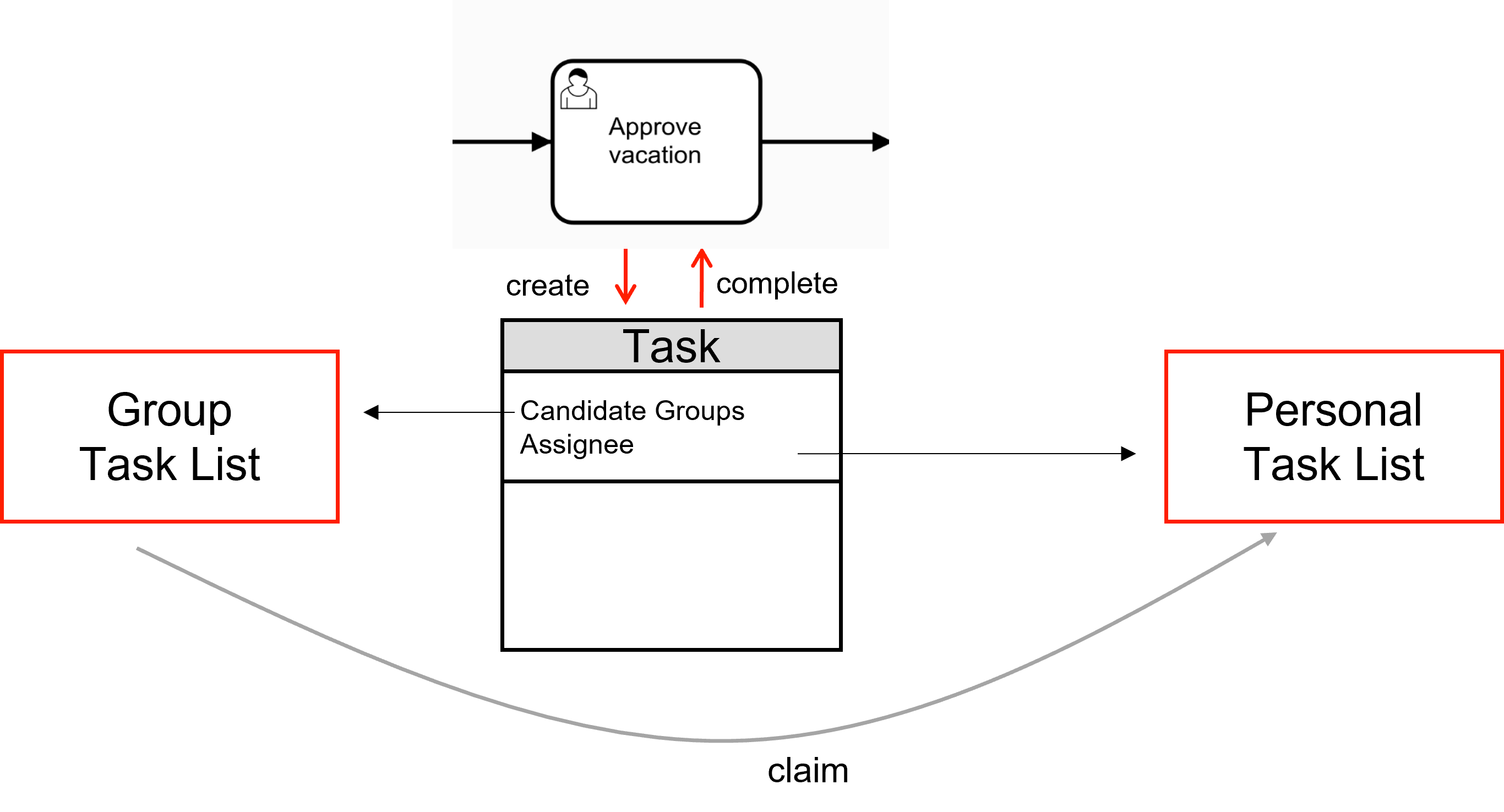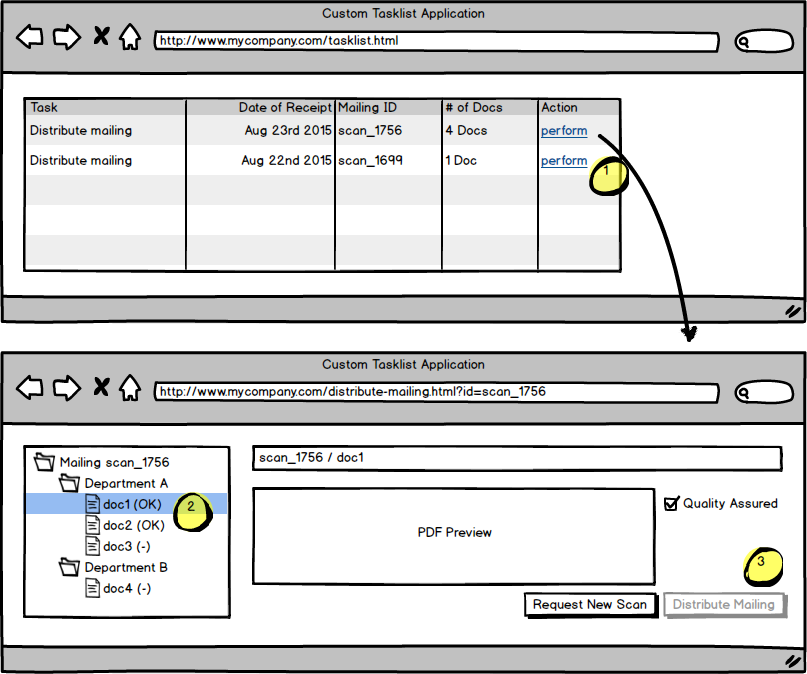Understanding human task management
Using task assignment features
The lifecycle of human tasks (like assigning, delegating, and completing tasks) is mostly a generic issue. There is no need to model common aspects into all your processes, if often makes models unreadable. Use Camunda task management features or implement your requirements in a generic way.

So every task can be assigned to either a group of people, or a specific individual. An individual can 'claim' a task, indicating that they are picking the task from the pool (to avoid multiple people working on the same task).
As a general rule, you should assign human tasks in your business process to groups of people instead of specific individuals.
<bpmn:userTask id="task_approve_vacation">
<bpmn:extensionElements>
<zeebe:assignmentDefinition candidateGroups="manager" />
</bpmn:extensionElements>
Then, require individual members of that group to explicitly claim tasks before working on them. This way, you avoid different people working on the same task at the same time. See claimTask.
claimTask(
taskId: String!
assignee: String
): Task!
You can also directly claim tasks in Camunda Tasklist with the click of a button.

While assigning users to groups is advised, it's not the only option. You could always assign a task to a single person who is supposed to complete the task (e.g. the individual 'customer' of your process or a coworker having specific knowledge for the case). You will need to have access to the specific person relevant for your process instance, e.g. via a process variable:
<bpmn:userTask id="task_approve_vacation">
<bpmn:extensionElements>
<zeebe:assignmentDefinition assignee="=assistant_username" />
</bpmn:extensionElements>
Deciding about your task list frontend
If you have human tasks in your process, you must make up your mind on how exactly you want to let your users work on their tasks and interact with the workflow engine. You have basically three options:
Camunda Tasklist: The Tasklist application shipped with Camunda. This works out-of-the-box and has a low development effort. However, it is limited in terms of customizability and how much you can influence the user experience.
Custom task list application: You can develop a custom task list and adapt this to your needs without compromises. Human tasks are shown inside your custom application, following your style guide and usability concept. You will use the Camunda Tasklist API in the background. This is very flexible, but requires additional development work.
Third party tasklist: If our organization already has a task list application rolled out to the field, you might want to use this for tasks created by Camunda. You will need to develop some synchronization mechanism. The upside of this approach is that your end users might not even notice that you introduce a new workflow engine.
Considerations for developing custom task lists
When building a custom tasklist/application, you must plan for the following aspects. You will need to
- Query for user tasks and generate lists of those tasks.
- Filter the list along specific attributes like current assignee, candidate groups, etc.
- Select and display the right forms for starting processes and completing tasks.
- Use custom/business value data in order to filter with those values and display them correlated with the task list and within forms.
- Authorize users to access those lists, filters, and forms.
Considerations for using third party task lists
When integrating a third party tasklist, you must plan for the following aspects. You will need to take care of:
- Creating tasks in the third party tasklist based on the user tasks created by Camunda.
- Completing tasks in Camunda and move on process execution based on user action in the third party tasklist.
- Cancelling tasks, triggered by Camunda or triggered by the user in the third-party tasklist.
- Transferring business data to be edited in the third-party tasklist back and forth.
Your third party tasklist application also needs to allow for some programmatic control of the lifecycle of its tasks. The third-party application must have the ability:
- To programmatically create a new task.
- To hook in code which programmatically informs other systems that the user is about to change a task's state.
- To manage custom attributes connected to a task and programmatically access them.
Additionally, it should have the ability
- To programmatically delete a task which was cancelled in Camunda. Without this possibility such tasks remain in the users tasklist and would need to be removed manually. Depending on the way you integrate the task completion mechanism, when the user tries to complete such tasks, they would immediately see an error or the action would just not matter anymore and serve as a removal from the list.
Transfer just the minimal amount of business data in between Camunda and your third-party tasklist application.
For creating tasks, transfer just the taskId and important business data references/ids to your domain objects. As much as possible should be retrieved later, and just when needed (e.g. when displaying task forms to the user) by requesting data from the process engine or by requesting data directly from other systems.
For completing tasks, transfer just the business data which originated from Camunda and was changed by the user. This means, in case you just maintain references, nothing needs to be transferred back. All other business data changed by the user should be directly transferred to the affected systems.
Task lists may not look like task lists
There are situations where you might want to show a user interface that does not look like a task list, even if it is fed by tasks. The following example shows such a situation in the document input management process of a company. Every document is handled by a separate process instance, but users typically look at complete mailings consisting of several such documents. In a customer scenario, there were people in charge of assessing the scanned mailing and distributing the individual documents to the responsible departments. It was important to do that in one step, as sometimes documents referred to each other.
So you have several user tasks which are heavily interdependent from a business point of view and should therefore be completed in one step by the same person.
The solution to this was a custom user interface that basically queries for human tasks, but show them grouped by mailings:

The custom tasklist shows each mailing as one "distribution task", even though they consist of several human tasks fetched from the workflow instance.
2The custom user interface allows you to work on all four human tasks at once. By dragging and dropping a document within the tree, the user can choose to which department the document is delivered to.
3In case the user detects a scanning problem, they can request a new scan of the mailing. But as soon as all documents are quality assured, the button Distribute Mailing gets enabled. By clicking on it, the system completes all four human tasks - one for each document - which moves forward the four process instances associated with the documents.